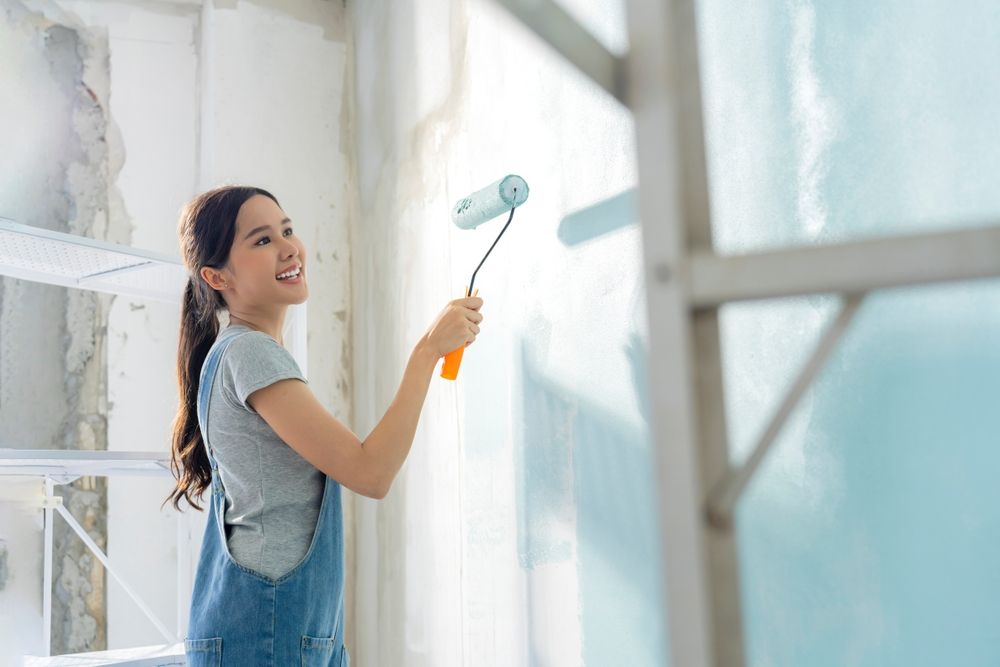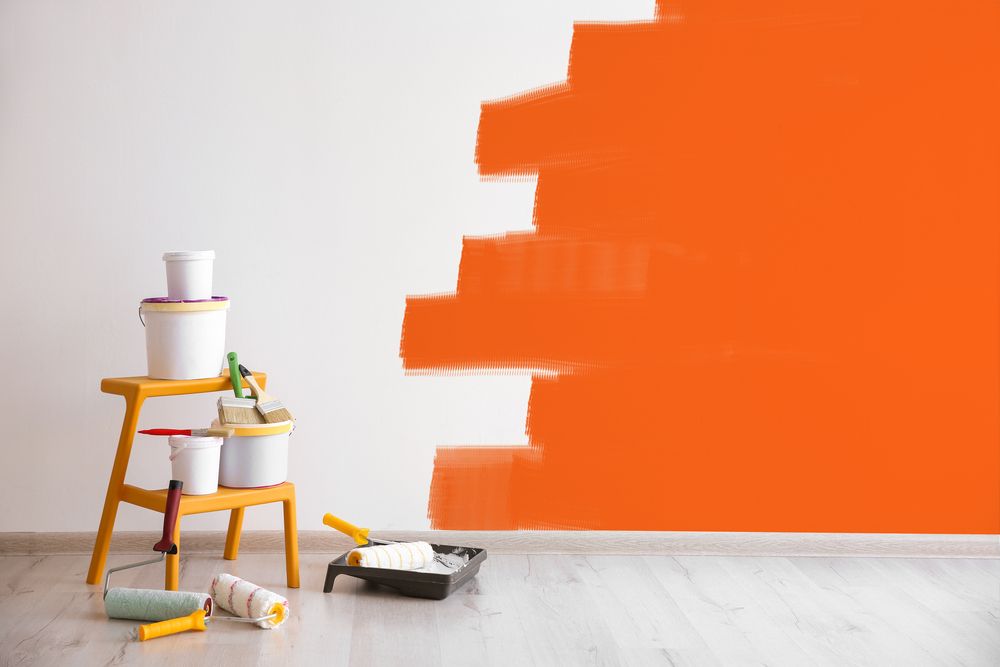Repainting your walls can refresh the look of a room, adding personality, and even influencing the perceived size and mood of the space. But with myriad paint finishes, bases, and colors available, making the right choice can be daunting. Beyond aesthetics, practical considerations—like the room’s function, lighting, and traffic levels—must shape your decision.
1. Deciding on Paint Type: Latex vs. Oil-Based
The first major choice typically revolves around whether you’ll use latex (water-based) paint or oil-based (alkyd) paint. While both can coat walls effectively, each offers distinct advantages in dry time, durability, and environmental impact.
Latex (Water-Based) Paint
- Pros:
- Faster dry times, often re-coatable in just a couple of hours.
- Easier cleanup with soap and water.
- Low VOC (volatile organic compound) options available, reducing fumes and health hazards.
- Maintains flexibility over time, reducing cracking.
- Cons:
- Some formulations might be less durable on high-traffic surfaces compared to oil-based, but modern latex paints have greatly improved in durability.
- Not ideal for covering surfaces that previously had heavy oil-based finishes unless properly prepped and primed.
Oil-Based (Alkyd) Paint
- Pros:
- Very durable, long-lasting finish with great leveling (reducing brush marks).
- Great for trim or surfaces that endure heavy use.
- Cons:
- Longer drying times; may require about 24 hours or more before re-coating.
- Higher VOC content and stronger odor during application.
- Cleanup demands mineral spirits or paint thinner.
2. Understanding Paint Finishes and Their Applications
Paint finishes (sheen levels) influence not just aesthetics, but also how well walls resist stains and reflect light. A finish too glossy can reveal imperfections, while a matte finish might not withstand frequent wiping.
Common Finish Types
- Flat (Matte)
- Features: Non-reflective, hides wall imperfections, can appear more subdued.
- Best For: Low-traffic areas (e.g., bedrooms, ceilings) or older walls with flaws you want to conceal.
- Drawback: Harder to clean—smudges or scuffs might not wipe away easily.
- Eggshell
- Features: Slightly more sheen than flat but still fairly low-luster.
- Best For: Moderate traffic rooms like living areas, hallways, and home offices.
- Balance: Offers modest washability along with some hiding of wall flaws.
- Satin
- Features: A gentle sheen that reflects more light, often used in kitchens and bathrooms.
- Pros: Easier to wipe down, more durable than eggshell.
- Cons: May highlight surface imperfections under bright light.
- Semi-Gloss
- Features: Noticeably shiny, reflecting quite a bit of light.
- Best For: Trim, doors, cabinets, bathrooms, or areas needing frequent cleaning.
- Note: Tends to show brushstrokes or any defects on the surface.
- High-Gloss
- Features: The shiniest finish, extremely reflective.
- Best For: Furniture or accent areas requiring a stand-out polished look.
- Caution: Prep must be perfect because high-gloss magnifies surface flaws.

3. Selecting Colors That Work with the Space
Color can drastically affect a room’s atmosphere. Warm hues invite coziness, cool shades evoke calm, and neutrals provide a versatile backdrop. The right choice sets the mood and complements existing décor.
Tips for Color Selection
- Test Swatches: Paint large sample areas or poster boards, observing how colors shift in morning vs. artificial light.
- Consider Undertones: A gray paint might have blue or green undertones that appear in certain lighting.
- Accent vs. Main Color: Accent walls or bolder colors can add drama, but ensure the rest of the space remains cohesive.
- Room Purpose: Relaxing spaces (bedrooms) often favor soothing neutrals or pastels; dynamic living areas might handle brighter or more saturated colors.
4. Factoring in Coverage and Quality
Some paints achieve full coverage in one coat, while others need multiple layers. High-quality paints might cost more initially but can save time and yield smoother results. Additionally, some lines offer primer+paint combos.
Quality Indicators
- Higher Pigment Load: Means better coverage, vibrant color with fewer coats.
- Reputable Brands: Known for consistent formulas and color accuracy.
- Washability: If a paint line emphasizes scrub or stain resistance, it’s usually more durable.
- Primer vs. Self-Priming: Self-priming paints can be convenient, but for drastic color changes or painting new drywall, a dedicated primer layer might still be beneficial.
5. Budgeting and Saving Strategies
Between paint, brushes, rollers, and other supplies, costs can add up—especially for large projects. Balancing quality with affordability is key, as cheap paint might actually lead to more coats or subpar finishes.
Cost Considerations
- Price per Gallon: Premium lines might run $40–$60 or more, while budget paints start around $20–$25.
- Coverage Rates: Some paints cover 350–400 sq ft per gallon; others might be less. If cheaper paint needs extra coats, it might not truly save money.
- Sales and Promotions: Watch for seasonal deals (holidays or hardware store events) to cut costs.
- Calculating Quantity: Measure your walls, subtract doors/windows, and factor a little extra for patch-ups later.
6. Prep and Application Tips
Even the best paint can yield poor results without proper prep, leading to peeling, uneven textures, or visible imperfections. Good prep sets the stage for a professional-looking outcome.
Prep Essentials
- Clean and Repair: Wipe down walls, fill holes or cracks, and lightly sand rough areas.
- Prime if Needed: Glossy or previously stained surfaces often need primer for optimal adhesion.
- Tape Edges: Protect trim, baseboards, and ceiling lines with painter’s tape for crisp edges.
- Use Quality Tools: Good brushes and rollers reduce streaks or lint transfer.
Application Reminders
- Stir Thoroughly: Pigments can settle; mixing ensures consistent color.
- Maintain Wet Edges: Overlap edges as you move across the wall to avoid lap marks.
- Multiple Thin Coats: If needed, rather than one thick coat that might run or dry unevenly.
Choosing the right paint for your walls is about more than just picking a pretty color swatch. It involves selecting a formula and finish that align with the room’s purpose, your household’s demands for durability, and your budget constraints. Start by identifying whether a latex or oil-based product suits your surface and preferences for cleanup. Decide on a sheen—from matte to high-gloss—based on how much traffic the room sees and how reflective or easy to clean you need the surface to be.
Spending time testing color samples in your actual space ensures the hue’s undertones work harmoniously with your lighting and décor. And while high-quality paints might cost a bit more upfront, they often deliver better coverage, vibrant color payoff, and lasting durability—meaning you won’t have to repaint as often. Pair your chosen paint with proper surface preparation, careful application, and finishing touches like crisp edges and thorough drying time, and you’ll achieve a professional-level look that can transform any room. By blending aesthetic vision with functional considerations, you’ll enjoy walls that look great and hold up to everyday life.



